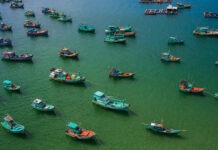Often overlooked in favor of its better-known neighbors, Laos remains one of Southeast Asia’s most enticing places. Once caught in the middle of the two Indochina wars, the landlocked country retains a slow, rather old-fashioned charm. Laos’ lifeline is the Mekong River, which runs the length of the country, at times bisecting it and at others serving as a boundary with Thailand.
For such a small country, it is surprisingly diverse in terms of people. Colorfully dressed hill tribes populate the higher elevations, while in the Lowland River valleys, coconut palms sway over the Buddhist monasteries of the ethnic Lao. Whether you are riding through the countryside on a rickety old bus or leisurely sailing down the Mekong, it is hard not to be won over by this utterly fascinating country and its people.

Vientiane: An unusually delicate, temple-strewn capital on the banks of the Mekong, Vientiane goes totally against the grain of Asian capitals, being a slow-paced, relaxing spot where you can hang around for more than just the tourist attractions. Home to hordes of ornate wats (temples) and littered with tuktuks and bigger jumbos, tourists spend days in Vientiane drifting out to the incredible out of town Buddha Park, or exploring the national symbol of Laos, the golden-spiked Pha That Luang.

Luang Prabang: The most popular place to visit in Laos, Luang Prabang is an historic city that once served as the capital of the Kingdom of Laos. Located at the confluence of the Mekong and Nam Khan rivers, the city has numerous Buddhist temples and monasteries, with monks walking through the city collecting alms in the morning. There are several waterfalls nearby, some of which offer elephant rides to visitors. A night market at the end of the town’s main street is a good place to buy souvenirs. Adventuresome eaters might want to try fried Mekong River moss, which is a local delicacy.

Luang Namtha: The provincial capital of Luang Namtha is the largest city in northwest Laos. It is a destination popular with backpackers, many of whom stop here while hiking from China to Laos. It is a good place to start treks into the hills to visit ethnic hill tribes. Renting a mountain bike or motorcycle is a good way to travel to nearby villages and waterfalls. After a day’s ride, visitors can relax with an herbal sauna. Night markets offer an opportunity to sample a wide variety of local foods cheaply.

Phonsavan: The name Phonsavan means ‘hills of paradise’. Phonsavan is a good place to experience the U.S.’s Old West, only with Laotian characteristics. Since cattle raising is one of the city’s main businesses, it is not uncommon to see Hmong ‘cowboys’ wearing violet and brown cowboy hats. The city even hosts bullfights during Hmong New Year.

Nong Kiau: Sometimes called Nong Khiaw, Nong Kiau is a popular tourist destination in Luang Prabang Province because of its many walking, mountain climbing and biking opportunities. A must-see site is the bridge across the Nam Ou River that connects the two parts of Nong Kiau, and is a good place to see stunning views of the river and mountains.

Si Phan Don: A beautiful set of islands, Si Phan Don is set against a scenic section of the Mekong River in Southern Laos. The Mekong is impassable to river traffic here due to the Khone Falls, a series of rapids that stretch 9.7 km of the river’s length. The Mekong below the falls has a small population of the highly endangered Irrawaddy Dolphins. The three principal islands that cater to tourists are Don Det, Don Khon and Done Kong.

Tham Kong Lo: Also known as Kong Lo Cave, Tham Kong Lo is a limestone cave in Phu Hin Bun National Park. Located on the Phu Hin Bun River, the cave has been described as a geological wonder of Southeast Asia. The karst cave is more than 6.5 km long and up to 91 meters high. It contains an emerald-colored pool that locals believe is sacred, saying it reflects the skin color of Indra, a Hindu god. A boat ride through the cave is a not-to-be-missed adventure.

Bokeo Nature Reserve: The Bokeo Nature Reserve was created to protect its population of the black-cheeked gibbon, rediscovered in 1997, which was previously thought to be extinct. A visit to Bokeo Nature Reserve is not complete without a stay at the Gibbon Experience, an eco-tourism conservation project. Guests stay in tree houses and travel by zip line through the forests in search of the Black Gibbon. Besides the elusive black gibbon, visitors to the reserve may also see elephants, bears, tigers and wild buffalo.

















